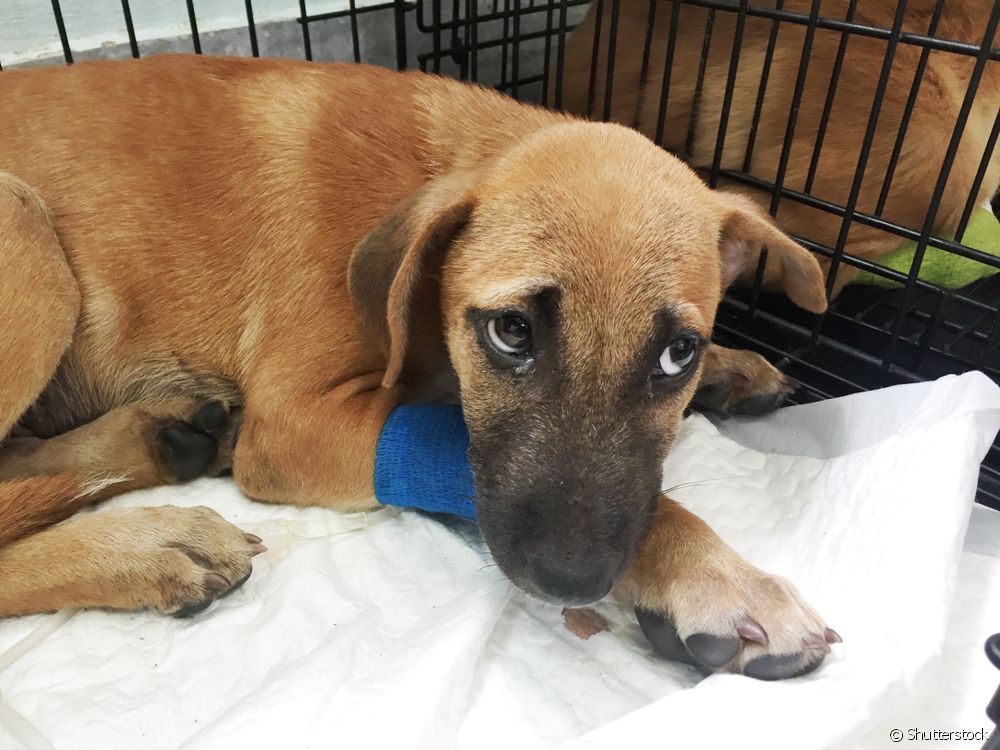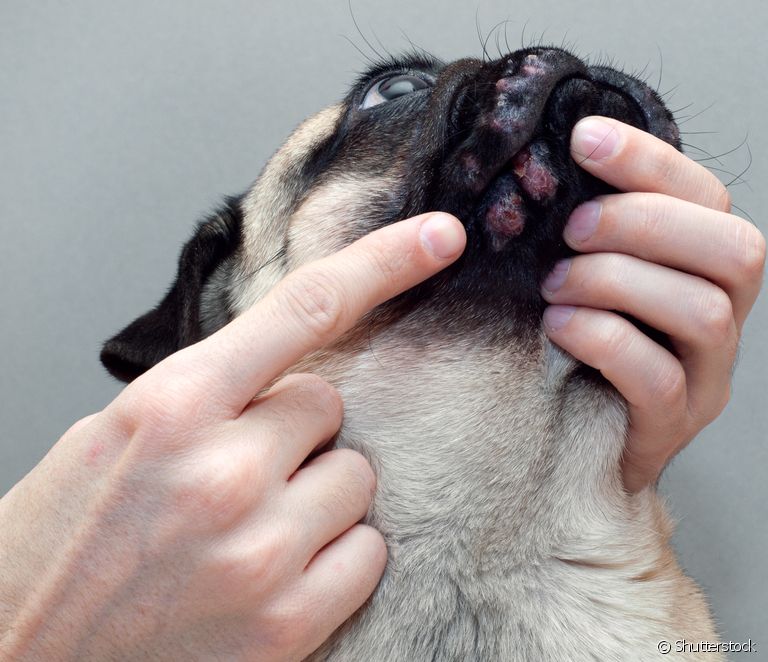Canine leishmaniasis: what it is, symptoms, treatment, vaccine and ways to prevent the disease

Table of contents
Canine leishmaniasis is a disease caused by a protozoan called Leishmania. Even though it is common in animals, leishmaniasis can also be transmitted to humans and is therefore classified as a zoonosis. In both cases, it attacks the patient's immune system and can weaken the body enough to be fatal. Among the symptoms of canine leishmaniasis, sores are quite commonIf it is visceral - another type of leishmaniasis manifestation - symptoms are usually more comprehensive.
But how does leishmaniasis act on the body? How to treat canine leishmaniasis wounds and what are the best ways to prevent the condition? To talk more about this dog disease and clarify doubts about leishmaniasis, what it is, contagion, symptoms, prevention and treatment, we talked to Ana Regina Torro, homeopathic veterinarian. Take a look!
What is canine leishmaniasis?
The main focus of action of Leishmania in the body of a dog is in the cells responsible for protecting the animal, that is, its immune system. "Canine leishmaniasis is a disease transmitted by a protozoan, called Leishmania, which is in the blood of infected dogs. The female of the straw mosquito bites this animal, contracts this parasite and, in a next bite, will infect another animal or a human.From there, the disease can reach a number of other organs and parts of the body, generating various symptoms of leishmaniasis.
See_also: Does dry bathing for cats work?What you need to know about the mosquito vector of leishmaniasis in dogs
The straw mosquito (Lutzomyia longipalpis) is a phlebotomine and haematophagous insect that belongs to the Psychodidae family. It is largely responsible for the transmission of leishmaniasis in dogs, humans and other animals. However, only female straw mosquitoes feed on blood and can transmit the protozoan Leishmania if they are infected with it.
It is not very difficult to recognize the straw mosquito: as its name suggests, the insect has a yellowish color that resembles straw. It is small, but has long wings with some hairs scattered around the body. This type of mosquito is common in humid places, with little light incidence and with a lot of organic matter around. The straw mosquito is also known as tatuquira, birigüi,dogwood, white wing, hard wing and straw, depending on the locality.
The prevalence is higher in wild and rural environments, but canine leishmaniasis has become increasingly "urban" in recent years. In Brazil, data from the Ministry of Health reveal that the North and Northeast regions are the most affected, mainly in the states of Amazonas, Acre, Pará, Mato Grosso and Bahia.

Canine leishmaniasis: symptoms involve the whole body of the animal
Symptoms of leishmaniasis will vary according to the presentation of the disease. "There are two types of leishmaniasis: cutaneous and visceral. In cutaneous leishmaniasis wounds in dogs do not heal, especially on the head and edges of the ears. They can also occur in the nose, mouth and throat. The dog's hair becomes ugly, matted and the skin flakes off, "explained Ana Regina.
On the other hand, the symptoms of canine leishmaniasis can be broader. This is one of the main difficulties in diagnosing canine visceral leishmaniasis. According to the specialist, in the visceral form the symptoms of leishmaniasis in dogs are usually:
- Anorexia
- Abnormal nail growth
- Loss of appetite
- Fever
- Anemia
- Prostration
- Enlargement of lymph nodes throughout the body
- Enlargement of spleen and liver
- Liver symptoms
- Predisposition to fall ill frequently without finding a definite cause.
New symptoms, such as the dog vomiting, diarrhea and difficulty peeing can arise according to each area affected by Leishmania. The specialist points out that, in dogs, the visceral form is more common and, often, the symptoms of leishmaniasis in dogs include those of the cutaneous and visceral forms together.
Because it is a disease that affects the animal's immune system, it is also common for them to catch other diseases while they have canine leishmaniasis, since their body is weakened and cannot protect itself normally. When the animal does not improve even after treatment, the professional and the guardians can begin to consider this as one of the symptoms of leishmaniasis in dogs.
Leishmaniasis sores in dogs are quite common
Wound, leishmaniasis, dog: these three words together make perfect sense when your pet is diagnosed with cutaneous leishmaniasis. That's because the leishmaniasis wound on a dog - or kala-azar sores on dogs, another popular name for the disease - is much more common than you might think.
See_also: Boiadeiroaustralian: everything you need to know about the dog breedBut how do dog sores form? Leishmaniasis causes a bruise at the site of the bite, which becomes covered with scabs and may be accompanied by purulent discharge. There may also be a kala-azar sore on a dog that does not heal, especially in the head area, as well as a sore on the dog's ear. Leishmaniasis, in some cases, can affect the mouth, throat and nose.
When looking for pictures of dogs with canine visceral leishmaniasis, you will find images of dogs with hair loss in various places on the body, flaking muzzle and skin ulcerations. These are the apparent signs of kala-azar, but they can also refer to other diseases, such as dermatological allergies, for example.






Dogs with leishmaniasis do not transmit the disease, but humans can catch it
Canine leishmaniasis is not contagious: transmission depends on a single vector, which is the straw mosquito. "Dogs with leishmaniasis do not transmit the disease directly through bites or feces or in any other way. The way the disease is transmitted is through the bite of the mosquito. The insect is very small, about the size of the head of a pin ", points out the specialist. As the mosquito usually puts the mosquitoes in the mouth.eggs in places rich in organic matter, leishmaniasis turns out to be a more common disease in areas with poor sanitation.
But there is nothing to fear if you suspect the disease in your dog. Leishmaniasis is not transmitted directly to humans. However, you should be especially careful about mosquitoes in the area where you live - and repellents play an important role in this protection.
If you get leishmaniasis, the treatment will depend on the type of disease you have. Cutaneous leishmaniasis does not usually require specific drugs, as the sores tend to disappear on their own, but the use of anti-parasitic drugs can speed up the patient's recovery. In visceral leishmaniasis, the doctor usually prescribes pentavalent antimonials.
Diagnosis of leishmaniasis in dogs
Precisely because of the wide variety of symptoms, canine leishmaniasis is a disease that cannot be accurately diagnosed only after consultation. "A histopathological examination or biopsy of some lesion can be done and there the parasites or parts of them will be found. Blood tests can also be done. The most common are serological tests, where antibodies are searched foragainst the agents, and PCR, where genetic sequences of leishmaniasis are found", explained the professional.
The most common type of test for accurate diagnosis of leishmaniasis involves observation of the protozoan: a small piece of the body or cells from a weakened organ are taken from the animal suspected of being infected and, by laboratory analysis, it is determined whether or not Leishmania is present in the sample taken. Blood tests help to detect whether Leishmania DNA is present among the cells in the animal.or count the levels of specific antibodies to fight the protozoan in your body.
It is worth noting that in endemic regions any abnormal symptom may be suspicious and the veterinarian should soon request tests. Therefore, do not look for "leishmaniasis dog symptoms" or "leishmaniasis dog wounds" on the internet. The most recommended is always to seek help from a qualified professional.

Is canine leishmaniasis curable?
As the infected animal is host to the protozoan that causes leishmaniasis, for a long time, when diagnosed with the disease, the dog was sacrificed because there is no complete cure. "Until 2016, euthanasia of the infected dog was requested. Since then, euthanasia is not mandatory, "explains the professional. Nowadays, there is a remedy for canine leishmaniasis that treats the symptomsand prevents the animal from becoming a transmitter of leishmania even if it is bitten by the straw mosquito.
"There are drugs that reduce the parasite load and drugs for the symptoms. The dog may be apparently cured, but may get sick again over time ", he points out. In this way, the pet can live healthily and with quality of life for longer, even with canine leishmaniasis. Still, the medication is expensive and the infected animal will need constant monitoring with the doctor.veterinarian - not just at the time you are diagnosed and need to treat the symptoms that manifest themselves.
Canine leishmaniasis: vaccine is an effective preventive measure
Since it cannot be completely cured, prevention turns out to be super important in combating the transmission and symptoms of leishmaniasis. One of the main ways to prevent it is the vaccine: canine leishmaniasis is one of the diseases that has immunization indicated for animals living in the proliferation points of the country. "There is a vaccine, which can only be applied to dogs without symptoms and with testIt is interesting in endemic regions and if there are infected animals nearby," explains Ana Regina.
The canine leishmaniasis vaccine can be administered from the age of four months and is divided into three doses with an interval of 21 days between each one. Talk to your veterinarian about the need for application!
3 ways to prevent canine leishmaniasis
In addition to up-to-date vaccination and maintaining the animal's health, you can also use other tricks to protect your friend from leishmaniasis. Dogs become infected with the disease only through the bite of the female straw mosquito, so the main focus is to avoid the bite, as the professional advises. In this sense, the tips are:
1) In places on the edge of forests or lakes or where there are contaminated animals, shelter dogs indoors with mosquito nets on doors and windows at dusk and dawn, which are the times of greatest mosquito attack.
2) Avoid walks at the times mentioned. If you go hiking with the dogs, put extra protection of repellent spray on ears and back.
3) Use a collar against canine leishmaniasis. Keep your dog on a collar or pipette medication that protects against mosquitoes as described in the package insert and pay attention to the reapplication date advised by the manufacturer.
Dog disease: leishmaniasis and the main features of the condition!
Cause of the disease : contaminated straw mosquito that bites the dog
Symptoms : leishmaniasis can have different clinical signs depending on the type. In the case of cutaneous, the presence of sores is common and canine leishmaniasis mainly affects the head and the edges of the ears. In the case of visceral, there are other symptoms: leishmaniasis in dogs include fever, anorexia, loss of appetite, prostration and anemia.
Treatment : the disease is treated with drugs that do not cure leishmaniasis, but bring the symptoms under control. Dogs can live a good quality of life in this way, without spreading the infection.
Prevention of leishmaniasis In addition, mosquito screens, repellents and the use of a leishmaniasis collar are good strategies to keep the mosquito away.

